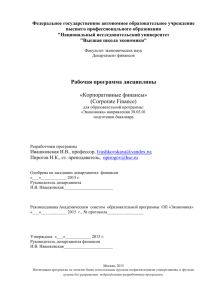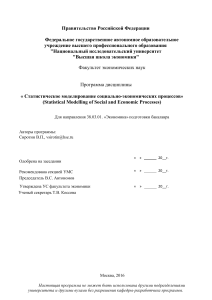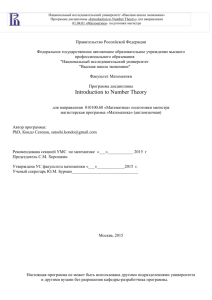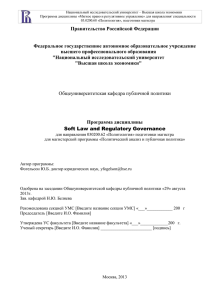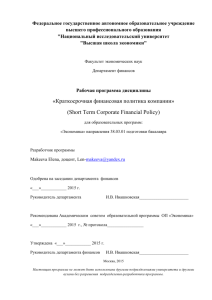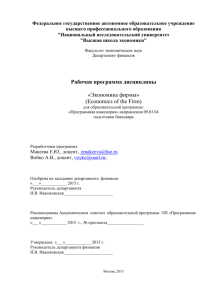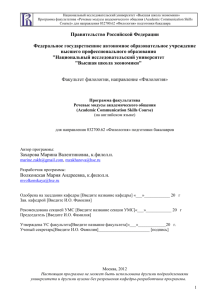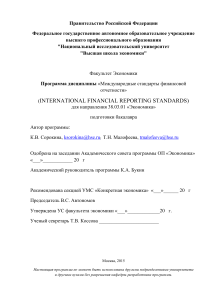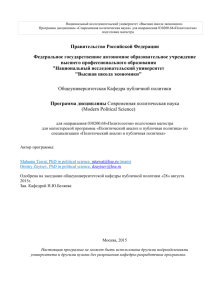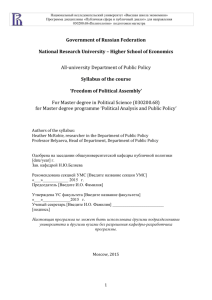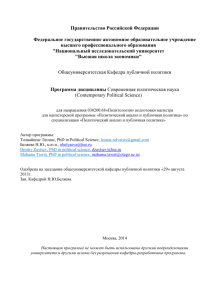2014-eng_corpfin - Высшая школа экономики
advertisement
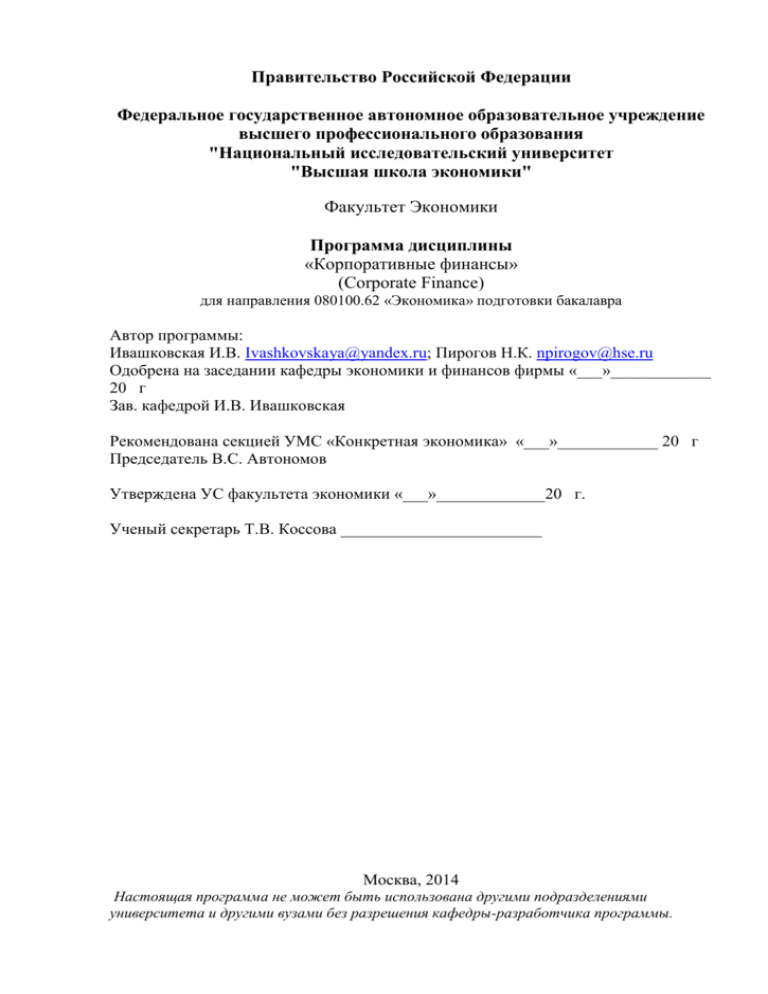
Правительство Российской Федерации Федеральное государственное автономное образовательное учреждение высшего профессионального образования "Национальный исследовательский университет "Высшая школа экономики" Факультет Экономики Программа дисциплины «Корпоративные финансы» (Corporate Finance) для направления 080100.62 «Экономика» подготовки бакалавра Автор программы: Ивашковская И.В. Ivashkovskaya@yandex.ru; Пирогов Н.К. npirogov@hse.ru Одобрена на заседании кафедры экономики и финансов фирмы «___»____________ 20 г Зав. кафедрой И.В. Ивашковская Рекомендована секцией УМС «Конкретная экономика» «___»____________ 20 г Председатель В.С. Автономов Утверждена УС факультета экономики «___»_____________20 г. Ученый секретарь Т.В. Коссова ________________________ Москва, 2014 Настоящая программа не может быть использована другими подразделениями университета и другими вузами без разрешения кафедры-разработчика программы. Национальный исследовательский университет «Высшая школа экономики» Программа дисциплины «Корпоративные финансы» (Corporate Finance) для направления 080100.62 «Экономика» подготовки бакалавра Syllabus CORPORATE FINANCE Faculty: Economics Year: 2014/15 Course name: Corporate Finance Level: Bachelor, 3Y Language of instruction: English Period: 4rd module Workload: 36 hours of classes Course description: The course develops theoretical framework for understanding and analysing major financial problems of a corporation operating in market environment. The course covers capital budgeting issues, capital structure theory, payout policy discussions and M&A motives. Corporate finance course is intended to provide necessary knowledge and basic skills in evaluating financing and investment decisions and their influence on corporate performance and value. The course prerequisites include Financial economics, Microeconomics (basic level) and Financial accounting. The course is based on lectures, classes, case studies and self-study. Course objectives: At the end of the course students are expected to: 1. Understand and apply principles of modern financial analysis; 2. Be able to discuss different stakeholders’ goals as a source of agency conflicts; 3. Understand and apply capital budgeting techniques when making an investment decisions; 4. Be able to discuss the logic of capital structure decisions and understand how market imperfections influence capital structure decisions; 5. Understand corporate payout decisions and be able to discuss market reaction to dividend payout; 6. Be able to discuss M&A motives and value creation via restructuring. Main readings: 1. Richard Brealey, Stuart Myers (B&M). Principles of Corporate Finance. McGraw Hill. 6th Edition. 2. Jonathan Berk, Peter DeMarzo (B&D). Corporate Finance. Pearson: 3rd edition, 2013. Teaching methods include: case studies group presentations and discussions in class problem solving lecturers& classes Course outline: 1. Corporate finance: Introduction. From accounting to financial approach. Market capitalization and enterprise value. Maximizing the value of the business as a key shareholders’ goal: financing decisions, investment decisions, payout policy. Financial decisions: changes across the lifecycle. 2 Национальный исследовательский университет «Высшая школа экономики» Программа дисциплины «Корпоративные финансы» (Corporate Finance) для направления 080100.62 «Экономика» подготовки бакалавра Company’s stakeholders: their goals and agency conflicts. Theory of the firm: ownership versus control of corporations. Corporations in emerging and developed markets: does business environment matter? Reading: B&D; M. Jensen and W. Meckling, Theory of the firm: Managerial behavior, agency costs and ownership structure, Journal of Financial Economics, (1976), 305-360. 2. Risk and return: from asset pricing models to cost of capital. Cost of equity. Shareholders, rational expectations and expected return estimation. Capital asset pricing model as a basis for expected return estimation. Fama-French model as an example of a multifactor model. Cost of debt. Return required by debtholders: bank loans & bond issues. Market view on cost of debt estimation: YTM and credit ratings. Weighted average cost of capital: opportunity cost of capital and a hurdle rate for investment projects. Reading: B&D; Fama, Eugene F.; French, Kenneth R. (1992). "The Cross-Section of Expected Stock Returns". Journal of Finance 47 (2): 427–465. 3. Investment decisions Investment opportunities of a corporation. Cash flows of an investment project. Project risk, cost of capital and discounted cash flows. Applying net present value methodology in capital budgeting. Mutually exclusive projects. Profitability Index as a relative measure of present value. Internal rate of return: methodology and limitations. Time constraints: discounted payback method. Value creation with efficient investment projects. Reading: B&M, B&D; 4. Capital structure choice and corporate value Modigliani and Miller theorem (MM) on capital structure, perfect capital market assumptions and basic MM irrelevance propositions. Shareholder reaction to changes in capital structure. MM propositions with corporate income taxes. Income tax shield as motivation to take debt. The effect of personal taxes on capital structure. Miller equilibrium model. Tradeoff theory as a model of optimal capital structure: tax shield vs financial distress costs. The pecking order of financing theory. The information conveyed by capital structure decisions. A debtholder equityholder conflict: debt overhang problem, asset substitution problem, debt covenants and monitoring opportunities as means to agency costs. An equityholder-manager conflict: overinvestment problem, deficient management efforts, aligning the conflicting interests with capital structure. Minimizing the total cost of two agency conflicts with capital structure choice. Reading: B&D; B&M; 3 Национальный исследовательский университет «Высшая школа экономики» Программа дисциплины «Корпоративные финансы» (Corporate Finance) для направления 080100.62 «Экономика» подготовки бакалавра Franco Modigliani and Merton Miller, The cost of capital, corporation finance and the theory of investment, American Economic Review, (1958), 261-297; Franco Modigiliani and Merton Miller, Corporate income taxes and the cost of capital, American Economic Review, 53 (June 1963), 433-443; Merton Miller, Debt and Taxes, Journal of Finance, (1977), 261-275; S. Ross, The determination of financial structure: The incentive signalling approach, Bell Journal of Economics 8 (Spring 1977), 23-40. (subject of the Thakor article above); S. Myers, The capital structure puzzle, Journal of Finance, 39 (1984), 575-592; S. Myers and N. Majluf, corporate financing and investment decisions when firms have information that investors do not have, Journal of Financial Economics, 13, (1984), 187-221. 5. Interrelation of financing and investment decisions Adjustments to capital budgeting techniques when evaluating a project under certain financing plan. Adjusted present value (APV), weighted average cost of capital (WACC) approach and free cash flow to equity (FCFE): three classic approaches. Reading: B&M, B&D; 6. Payout policy and corporate value Types of dividends: cash dividend, stock dividend, share repurchase. Payout policy as a financing problem. Lintner’s stylized empirical facts. The Modigliani&Miller payout irrelevance theorem. The effect of investor taxes: a preference for capital gains compared to cash distributions. The dividend puzzle. Static clientele theory. Signaling role of dividends. Payout decisions as means to align the interests of managers and shareholders. Reading: B&D; B&M Black, Fischer, and Myron Scholes. “The Effects of Dividend Yield and Dividend Policy on Common Stock Prices and Returns.” Journal of Financial Economics 1 (1974), pp. 1–22. Litzenberger, Robert, and Krishna Ramaswamy. “The Effects of Dividends on Common Stock Prices: Tax Effects or Information Effects?” Journal of Finance 37, no. 2 (1982), pp. 429–43.Pettit, Justin. “Is a Share Buyback Right for Your Company?” Harvard Business Review, April 2001, 7. M&A and restructuring Types of M&A. Reasons to acquire: economies of scale, vertical integration, financing side motivation. Hubris hypothesis by Roll. Empirical evidence of inefficient M&As. Value creation via restructuring. Divestitures and bankruptcy as types of corporate restructuring. The sources for synergy in restructuring. Reading: B&D; B&M; Grossman, S., and O. Hart, Takeover bids, the free rider problem, and the theory of the corporation, Bell Journal of Economics 11 (1980), 42-64. Roll, R. The Hubris Hypothesis of Corporate Takeovers, Journal of Business, 59 (1986), 197216. 8. Applying corporate finance tools: industry-specific features. Industry-specific discussion of corporate finance decisions. Examples of real corporate investment and financing decisions. 4 Национальный исследовательский университет «Высшая школа экономики» Программа дисциплины «Корпоративные финансы» (Corporate Finance) для направления 080100.62 «Экономика» подготовки бакалавра Workload distribution Topic # 1 2 3 4 5 6 7 8 Corporate Finance: Introduction Risk and return: from asset pricing models to cost of capital Investment decisions Capital structure choice corporate value Interrelation of financing and investment decisions Payout policy and corporate value M&A and restructuring Applying corporate finance tools: industry-specific features Total hours Grading total 100% participation 10% midterm exam 35% referat (groupwork and presentations) 20% final exam 35% 5 Lectures (hours) Classes (hours) Self-study (hours) 4 4 2 10 12 8 6 4 6 12 18 4 4 12 4 2 10 4 2 2 4 10 16 36 24 162
